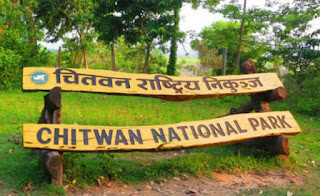Nestled at the foot of the Himalayas, Chitwan has a particularly rich flora and fauna and is home to one of the last populations of single-horned Asiatic rhinoceros and is also one of the last refuges of the Bengal Tiger. Chitwan National Park (CNP), established in 1973, was Nepal’s first National Park And a World Heritage Site enlisted by UNESCO. Located in the Southern Central Terai of Nepal, it formerly extended over the foothills, the property covers an area of 93,200 hectares, extends over four districts: Chitwan, Nawalparasi, Parsa and MakwanpurUNESCO
SOME FACTS ABOUT CHITWAN NATIONAL PARK:
-The word 'Chitwan' means 'Heart of the Jungle.'Chitwan National Park is considered to be one of Asia's best national parks for viewing wildlife.
-The Chitwan National Park has the highest number of adult tigers at 93 followed by 87 in Bardiya National Park AS per the new Census Report.
-In 2015 One horned Rhinoceros counted to 645 which is huge increase from past record.
-Chitwan National Park exists within a high humidity region that experiences a tropical monsoon climate. The monsoon season runs from the middle of June until the end of September.
-Flora and Fauna:
A total of 68 species of mammals , 56 species of herpeto fauna,543 bird species and 113species of fish have been recorded in the park.The park is especially renowned for its protection of One Horned Rhinoceros, Royal Bengal Tiger and Gharial Crocodile. The park harbors not only the world’s largest terrestrial mammal (wild elephant) but also the world’s smallest terrestrial mammal (pygmy shrew). Approximately two-thirds of the globally threatened species of birds found in Nepal are found in Chitwan National Park. There have been as many as 543 different bird species recorded in the park.Birds found in Chitwan National Park include the grey-crowned prinia, Bengal florican, and many other species including 22 pdfglobally threatened species including critically endangered Bengal Florican, Slender-billed Vulture, White-rumped Vulture and Red-headed Vulture .There are still butterfly, insect, and moth species being newly recorded in Chitwan National Park.There are at least 113 fish species in the waters of Chitwan, along with mugger crocodiles. There are also monitor lizards, rock pythons, king cobras, and tortoises.
-Chitwan National Park is a major tourist destination - one of Nepal's most popular with numbers of visitors increasing steadily.There are lodges where visitors can stay when visiting Chitwan National Park. Because it takes several days to really experience the wildlife viewing in the park visitors are advised to spend a minimum of two days exploring.
-Aside from the natural beauty and wildlife to be seen in the park, highlights of Chitwan National Park and its surrounding area include the Elephant Breeding Center, Wildlife Display and Information Center, Tharu villages that surround the park, Tharu Cultural Museum, and the Bird Education Society.
Vulture Comeback after long time
-
World’s first community managed vulture restaurant lies within Kawasoti municipality in Nawalparasi district, and is on the buffer zone of Chitwan National Park. Chitwan National Park has been declared as a World Heritage Site by UNESCO as well as being identified as an Important Bird and Biodiversity Area (IBA) by BirdLife International.
FOR VISITORS:
1.Entry to CNP:Sauraha in the East and Meghauli in the west.Nearest airport is the Bharatpur Airport.
2.WHAT TO SEE
-Gharial Breeding Centernear Kasara.
-Lake LamitalLake DevitalBikram Baba', a religious site.
-Chitwan Hatisar Elephant Breeding CenterA museum about elephants in Nepal and stalls for about 10 female elephants with their young ones, which are chained and don't look too happy, although breeding elephants for the national park is supposedly helpful.
-Bishajari Tal (20,000 Lakes). This lake chain is made up of many small lakes spreading and covering huge area of national park. The name however, doesn't derive from the number of lakes, but from the fact that the lakes are about 20,000 ft (6,100 m) from the highway - a slight disappointment. You can do a bicycle tour to the lakes, which is quite nice as you see the nature and observe many birds, crocodiles and quite often see a rhino.
-World Elephant Polo Competition only in Nepal on every december.
-Local native dances - quite interesting and usually included in your "hotel package". Stick dancing is very loud as they hit sticks together to form a rhythm.
-Valmiki Ashram:A small temple and ashram or hermitage just inside Chitwan National Park. Valmiki is named after the sage Valmiki, who is said to have written his epic Ramayan in a retreat that is located in these rolling hills many thousands of years ago. Walk around the large ghat area in the morning and evening to see locals performing their religious as well hygienic duties.
3.How to visit all park area:
-Pony & trap Pony rickshaws for 2 people
-Ox cart Bigger groups can be pulled by 2 oxen
-Elephant safari
-Jeep
-Boating in Rapti river
Some useful links to know more about chitwan national park:





















No comments:
Post a Comment